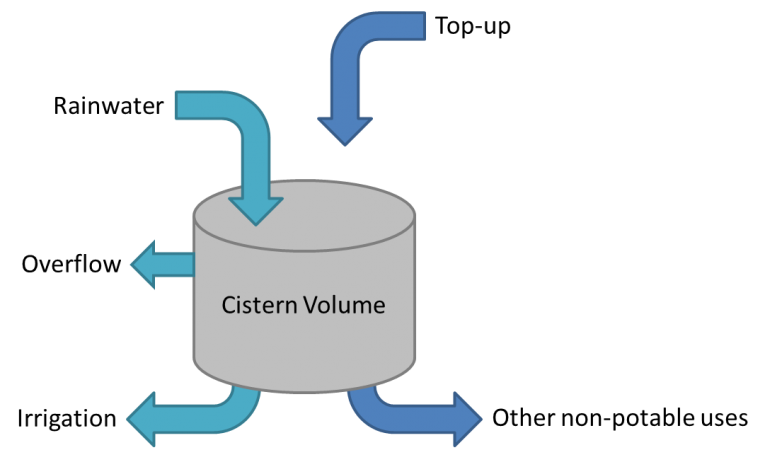Difference between revisions of "Rainwater harvesting: Sizing and modeling"
Jenny Hill (talk | contribs) (→Rapid) |
Jenny Hill (talk | contribs) |
||
| Line 69: | Line 69: | ||
---- | ---- | ||
| − | ===The Treatment Train Tool=== | + | ====The Treatment Train Tool==== |
</div> | </div> | ||
<div class="col-md-8"> | <div class="col-md-8"> | ||
| − | <p> Once the size of cistern has been determined, it can easily be | + | <p> Once the size of cistern has been determined, it can easily be modeled in many open source and proprietary applications. </p> |
<p> In addition to the cistern size, this watershed scale modelling requires input information about draw down time. i.e. the rate of use. </p> | <p> In addition to the cistern size, this watershed scale modelling requires input information about draw down time. i.e. the rate of use. </p> | ||
| + | In a typical configuration: | ||
| + | <ul> | ||
| + | <li>The catchment (roof) would be 100% impervious</li> | ||
| + | <li>The rainwater harvesting system would be a 'Storage' Element with the following properties:</li> | ||
| + | <ul> | ||
| + | <li>Storage type = No removal</li> | ||
| + | <li>Lined</li> | ||
| + | <li>Underlying soil = <em>doesn't matter, can ignore</em></li> | ||
| + | <li>Evaporation factor = 0</li> | ||
| + | <li>Suction head (mm) = 0</li> | ||
| + | <li>Saturated conductivity (mm/hr) = 0</li> | ||
| + | <li>Initial soil moisture deficit (fraction) = 0</li> | ||
| + | </ul> | ||
| + | The dimensions of the rainwater cistern can be placed into the fields: | ||
| + | <ol> | ||
| + | <li>Bottom elevation (m)</li> | ||
| + | <li>Maximum depth (m)</li> | ||
| + | <li>Initial water depth (m)</li> | ||
| + | <li>The Curves table is set up to accommodate ponds of roughly conical dimensions. A rainwater cistern is usually cuboid or cylindrical in shape, so that the area (m<sup>2</sup>) will remain the same throughout the depth. </li> | ||
| + | |||
</div> | </div> | ||
<div class="col-md-4"> | <div class="col-md-4"> | ||
| Line 80: | Line 100: | ||
<div class="col-md-12"> | <div class="col-md-12"> | ||
---- | ---- | ||
| − | |||
[[category:modeling]] | [[category:modeling]] | ||
Revision as of 17:30, 1 August 2017
Rapid[edit]
Five percent of the average annual yield can be estimated:
Y0.05= A × Cvol, A × Ra × e × 0.05
Y0.05 = Five percent of the average annual yield (L)
A = The catchment area ( m2)
Cvol, A = The annual runoff coefficient for the catchment
Ra = The average annual rainfall depth (mm)
e = The efficiency of the pre-storage filter
- Filter efficiency (e) can be reasonably estimated as 0.9 pending manufacturer’s information.
- In a study of three sites in Ontario, STEP found the annual Cvol, A of the rooftops to be around 0.8 [1]. This figure includes losses to evaporation, snow being blown off the roof, and number of overflow events.
Five percent of the average annual demand (D0.05) can be estimated:
D0.05 = Pd × n × 18.25
D0.05 = Five percent of the average annual demand (L)
Pd = The daily demand per person (L)
n = The number of occupants
Then the following calculations are based upon two criteria:
- A design rainfall depth is to be captured entirely by the RWH system.
- The average annual demand (D) is greater than the average annual yield (Y) from the catchment.
When Y0.05/ D0.05 < 0.33, the storage volume required can be estimated:
VS = A × Cvol × Rd × e
VS = Storage volume required (L)
A = The catchment area (m2)
Cvol, E = The design storm runoff coefficient for the catchment
Rd = The design storm rainfall depth (mm), and
e = The efficiency of the pre-storage filter.
- Good catchment selection means that the runoff coefficient, for a rainstorm event (Cvol, E) should be 0.9 or greater.
When 0.33
< Y0.05/ D0.05
< 0.7, the total storage required can be estimated by adding Y0.05:
Total storage = VS + Y0.05
<panelInfo>
</panelInfo>
STEP Rainwater Harvesting Tool[edit]
The Sustainable Technologies Evaluation Program have produced a rainwater harvesting design and costing tool specific to Ontario. The tool is in a simple to use Excel format and is free to download.
The Treatment Train Tool[edit]
Once the size of cistern has been determined, it can easily be modeled in many open source and proprietary applications.
In addition to the cistern size, this watershed scale modelling requires input information about draw down time. i.e. the rate of use.
In a typical configuration:
- The catchment (roof) would be 100% impervious
- The rainwater harvesting system would be a 'Storage' Element with the following properties:
- Storage type = No removal
- Lined
- Underlying soil = doesn't matter, can ignore
- Evaporation factor = 0
- Suction head (mm) = 0
- Saturated conductivity (mm/hr) = 0
- Initial soil moisture deficit (fraction) = 0
The dimensions of the rainwater cistern can be placed into the fields:
- Bottom elevation (m)
- Maximum depth (m)
- Initial water depth (m)
- The Curves table is set up to accommodate ponds of roughly conical dimensions. A rainwater cistern is usually cuboid or cylindrical in shape, so that the area (m2) will remain the same throughout the depth.
<btnPrimary>The Treatment Train Tool</btnPrimary>
